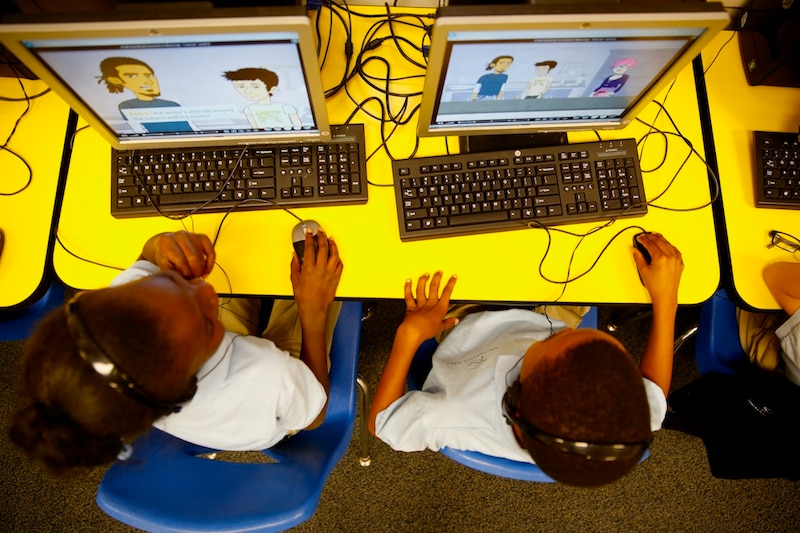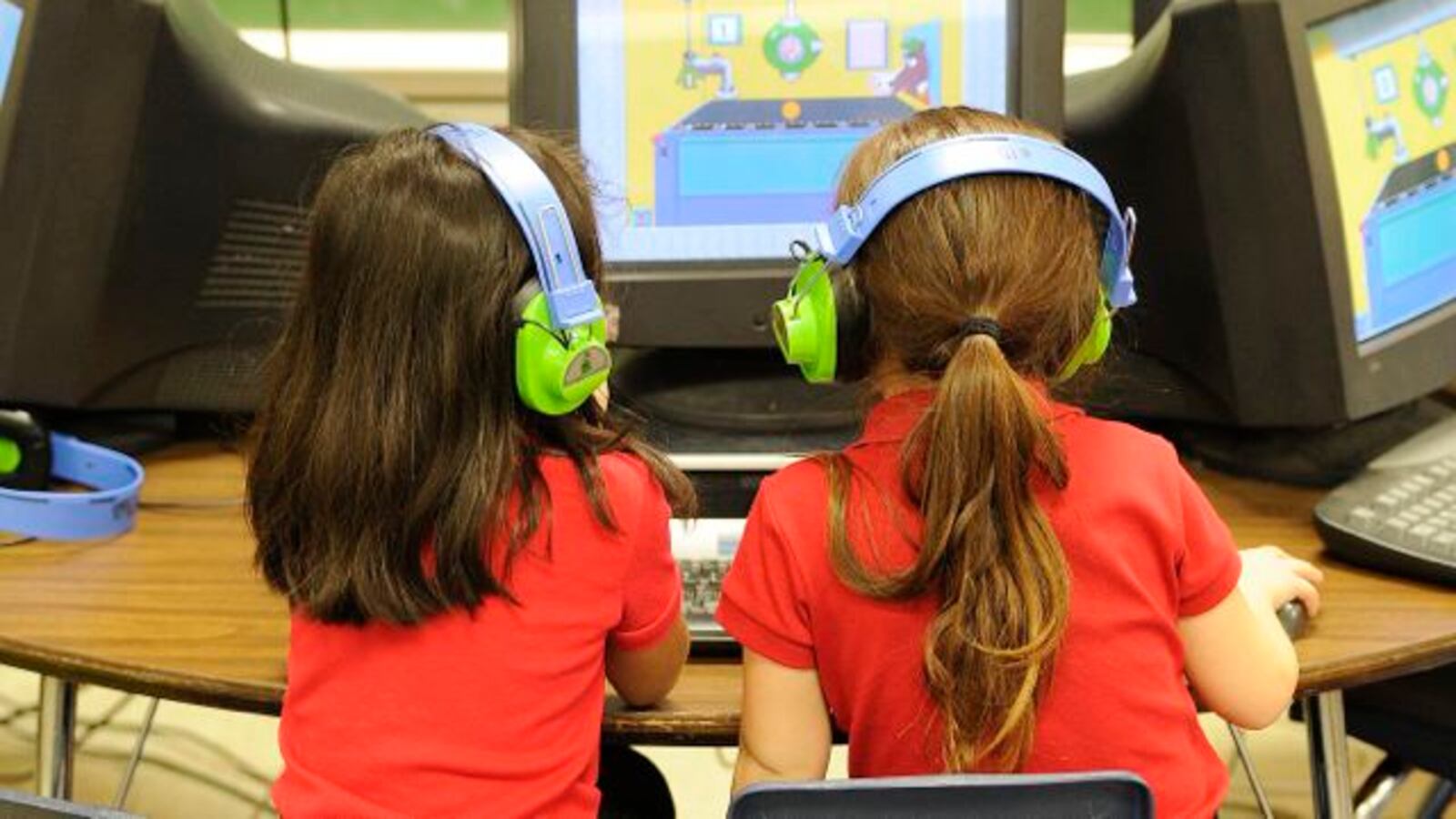Philanthropists and school leaders need to make a “big bet” on dramatically reshaping schools, according to the leaders behind last week’s major education conference.
Re-imagining learning, schools of tomorrow, personalized learning, jobs of the future — these were the watchwords at the New Schools Venture Fund Summit. Ideas about how to reinvent schooling were more prominent than even hot-button topics like school integration or vouchers.
“The world has changed dramatically … and our schools have struggled to keep up,” said New Schools CEO Stacey Childress at the summit’s opening session. “We just think it’s time to update the way schools work so they better prepare students for success in today’s world.”
The solution, according to some, is a focus on innovative school models — particularly ones that use technology to “personalize” teaching based on students’ needs, desires, strengths, and weaknesses.
The gathering was underwritten by deep-pocketed funders known for backing technology-based education initiatives, including the Gates Foundation and the relatively new Chan Zuckerberg Initiative. (Gates is a supporter of Chalkbeat, as are the Walton Family Foundation and the Carnegie Corporation, which were also major sponsors of the event.)
Advocates are extremely optimistic about investing in this new breed of schools. A report released by New Schools at the end of last year made an aggressive call to direct $4 billion in philanthropy toward creating, studying, and promoting this sort of innovation. Doing so, the authors write, will produce an estimated 200 to 500 percent return on investment.
It’s a remarkable claim, but perhaps an overly rosy one: the author of the study that New Schools relied on to make such a strong assertion says it’s likely inflated. And although some studies point to the benefits of specific technology programs, the research about whole schools using these approaches remains in its infancy.
As the ideas gain prominence, skeptics fear that the push amounts to the latest fad in education.
“What I see … is people imagining that if we just design the school with new models we will be able to satisfy the needs of the future,” said Ben Riley, head of the group Deans for Impact and former New Schools staff member. “The graveyard of people thinking they could successfully predict the future and then finding out that they were wrong about that has a lot of tombstones.”
The appeal of innovative schools and a personalized approach
Amidst a sea of buzzwords, it can be hard to define school innovation or personalized learning. (Some even argue that trying to pin down a clear meaning is misguided.)
Roughly speaking, though, the idea epitomized at the New Schools summit focuses on expanding technology in schools to better tailor teaching to specific students’ needs and desires.
The New Schools report points to several traits of these schools: maximizing “time, pace, instructional methods and outside experiences”; using “an expanded definition of student success”; ensuring students “feel ownership of their learning”; more frequent use of technology; and ensuring students build trusting relationships.
Advocates often point to Summit Public Schools, a charter school network in California that embraces a technology-infused model. A favorable case study authored by David Osborne of the reform-oriented Progressive Policy Institute calls them “schools of the future.”
Students at Summit spend about 16 hours a week — half of their school time — learning via computer. As Osborne describes it: “Teachers were there to answer questions, make suggestions when kids got stuck, and check their progress, but students were in charge of their own learning. They worked at their own pace, and when they felt they had mastered a concept, they took a 10-question assessment. If they could answer eight of the questions correctly, they checked that off and moved on to the next topic.”
Supporters of that approach highlight an analysis released by the RAND Corporation and the Gates Foundation. The study, which looked at schools funded by Gates because of their “promising approaches to personalized learning,” found that students made much larger gains on standardized tests compared to peers with similar characteristics attending different schools.
There is broader evidence that specific technology programs can improve achievement. Studies of computer programs designed to help students with algebra and early literacy, as well as the math program used by the Rocketship charter network, have shown benefits for students.
“The findings in general are very positive, especially for math,” said Andre Nickow, a Northwestern graduate student who worked on an analysis of technology-based personalized learning that was recently presented at a research conference.
Proponents also say the push for personalized learning is based on a deeper understanding of how kids learn — and how they can benefit from individualized instruction.
“The evidence base for the benefits of 1:1 mastery-based instruction is quite strong,” said Debbie Veney, a spokesperson for New Schools, pointing to a 1984 analysis of individual tutoring by prominent educational psychologist Benjamin Bloom, creator of the well-known Bloom’s taxonomy.
But providing each student a personal tutor is prohibitively expensive; the idea is to use technology to provide that personalization at a fraction of the cost.
“The innovative schools we and others support are working to find ways to produce similar academic results for students by using a mix of instructional approaches,” Veney said. “The early results of schools working on this challenge are quite promising, including the schools in the RAND study.”

The concerns about existing research
Indeed, that RAND study of innovative schools using personalized learning is often cited in these conversations. But there are a few reasons to view the findings cautiously.
The first is how New Schools frames the results in its report. Based on the RAND analysis, New Schools estimates a 200–500 percent return on the $4 billion the group argues philanthropists should invest over 10 years. But John Pane, author of the RAND study, disputes those projections.
“I was not really keen on some of the leaps that they were making based off of our data,” he told Chalkbeat. Pane himself estimated a potential return on investment and said he found “vastly smaller numbers” than New Schools did. (He declined to share his exact figures because his results have not gone through peer review yet.)
Veney said that the method in the report — converting effects on test scores into days of learning — is common in education research, including the CREDO charter studies.
The report has another major limitation, which Pane acknowledges: the schools in the study had to go through a rigorous application process in order to receive funding. That means the academic gains described in the study may not be the result of the schools’ use of personalized learning per se, but simply the possibility that only high-performing schools were examined.
“For me, the headline was good schools do good things,” said Alex Hernandez, a partner at the Charter School Growth Fund, which invests in new school models.
Regarding the two leading “pioneers” identified by New Schools, the research is also limited. Studies of the New Classrooms model, a personalized learning program that began in New York City known as Teach to One, have found mixed results. There does not appear to be any external empirical research on Summit Public Schools, though an internal analysis says students in the schools make large gains on standardized tests.
Skeptics say that the theory behind personalized learning has some inherent flaws, too.
For instance, Diane Tavenner, Summit’s CEO, previously said, “Look at the economy: it’s not about concrete knowledge, it’s about higher-order thinking skills, and the ability to perpetually learn and grow.”
Sentiments like that worry Ben Riley, who argues that the best way to train students for the jobs of tomorrow is to “provide them with a really rich, broad comprehensive education that gives them the knowledge base that allows them to adapt to those new jobs.”
“If there’s one thing that cognitive science has shown over and over again, it’s that our ability to understand new ideas depends on what ideas we already know,” said Riley, whose group released a report compiling research on the science of learning.
Meanwhile, unmentioned in New Schools’ report is research on fully virtual schools, in which instruction is delivered exclusively online. Although supporters might not categorize this approach as personalized learning, the schools are certainly different from traditional schools in their reliance on technology. And yet the results to date have been abysmal — students have generally seen large drops in test scores relative to those in brick-and-mortar schools. This suggests that expanding technology in education can come with significant risks.
If it fails, move on — but who is left behind?
New Schools acknowledges that these innovative schools aren’t a sure thing. (It is calling the plan a “big bet,” after all.) But trying out new structures for schools is necessary to prepare more students to succeed in college, especially the black, Hispanic, and low-income students who haven’t been served well by typical schools, they argue.
“If after several years this approach isn’t living up to the potential we imagine, let’s change course,” the report states. “But let’s also evaluate every other idea for how to direct the $20 billion in education philanthropy over the next 10 years based on concrete estimates of the improved outcomes we should expect for students.”
As schools experiment, “We will fail,” said Derwin Sisnett, cofounder of the Gestalt Community Schools charter network, at the summit.
But critics of the approach say such failure could lead to collateral damage.
“Should philanthropists scrap the initiative after five years, 1,700 schools will be left to deal with the aftermath and lost funding despite the many constraints they face,” wrote Jeffrey Snyder of Cleveland State University in a critical review of the New Schools report for the National Education Policy Center, which is partially funded by teachers unions.
Veney of New Schools said the group’s vision is to use philanthropic funds temporarily to jumpstart innovation. “Our proposal is to support educators who want to make the shifts with the resources they need to do it well,” she said, “and to ensure that the designs and practices they are adopting are sustainable with public funding after the first few years.”
Snyder, though, writes that the risks extend beyond the financial considerations. “Especially concerning should be the potential for this philanthropic shift to continue (and exacerbate) reform churn — the process where schools move quickly among reforms, never allowing any to take root.”


